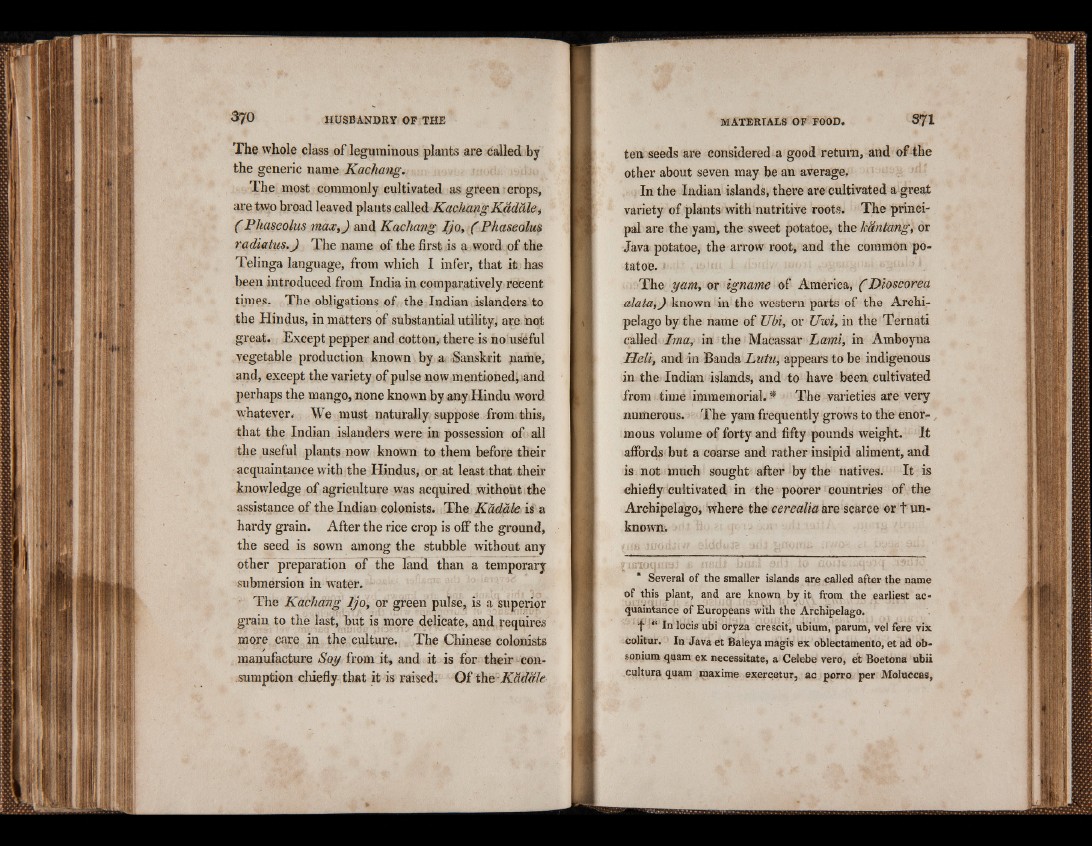
The whole class of leguminous plants are called by
the generic name Kachang.
The most commonly cultivated as green crops,
are two broad leaved plants called Kachang Kàdâle,
( Phaseolus max,) and Kachang Ijo, ( Phaseoius
radia tus. J The name of the first is a word of the
Telinga language, from which I infer, that it has
been introduced from India in comparatively recent
times. The obligations of the Indian islanders to
the Hindus, in matters of substantial utility, are not
great. Except pepper and cotton, there is no useful
vegetable production known by a Sanskrit name,
and, except the variety of pulse now mentioned,and
perhaps the mango, none known by any Hindu word
whatever. We must naturally suppose from this,
that the Indian islanders were in possession of all
the useful plants now known to them before their
acquaintance with the Hindus, or at least that their
knowledge of agriculture was acquired without , the
assistance of the Indian colonists. The Kâdàle is a
hardy grain. After the rice crop is off the ground,
the seed is sown among the stubble without any
other preparation oT the land than a temporary
submersion in water.
The Kachang Ijo, or green pulse, is a superior
grain to the last, but is more delicate, and requires
more care in the culture. The Chinese colonists
manufacture Soy from it, and it is for their consumption
chiefly that it is raised. Of the-Kâdale
ten seeds are considered a good return, and of the
other about seven may be an average.
In the Indian islands, there are cultivated a great
variety of plants with nutritive roots. The principal
are the yam, the sweet potatoe, the kantang, or
Java potatoe, the arrow root, and the common potatoe.
2
The yam, or igname of America, ('Dioscorea
alata,) known in the western parts of the Archipelago
by the name of Ubi, or Uwi, in the Ternati
called Irna,- in the Macassar Lami, in Amboyna
Heli, and in Banda Lata, appears to be indigenous
in the Indian islands, and to have been cultivated
from time immemorial. £ The varieties are very
numerous. - The yam frequently grows to the enormous
volume of forty and fifty pounds weight. It
affords but a coarse and rather insipid aliment, and
is not much sought after by the natives. It is
chiefly cultivated in the poorer countries of the
Archipelago, where the cerealia are scarce or + unknown
»
* Several of the smaller islands are called after the name
of this plant, and are known by it from the earliest acquaintance
of Europeans with the Archipelago.
f In locis ubi oryza crescit, ubium, parum, vel fere vix
colitur. In Java et Baleya magis ex oblectamento, et ad ob-
sonium quam ex necessitate, a Ceiebe vero, et Boetona ubii
cultura quam maxime exercetur, ac porro per Moluccas,